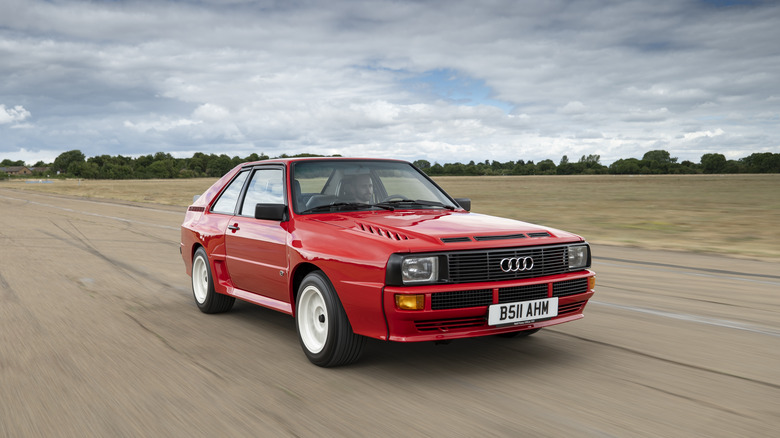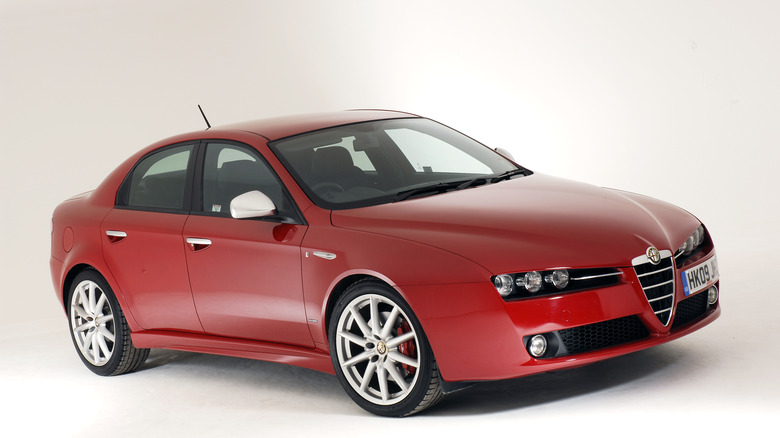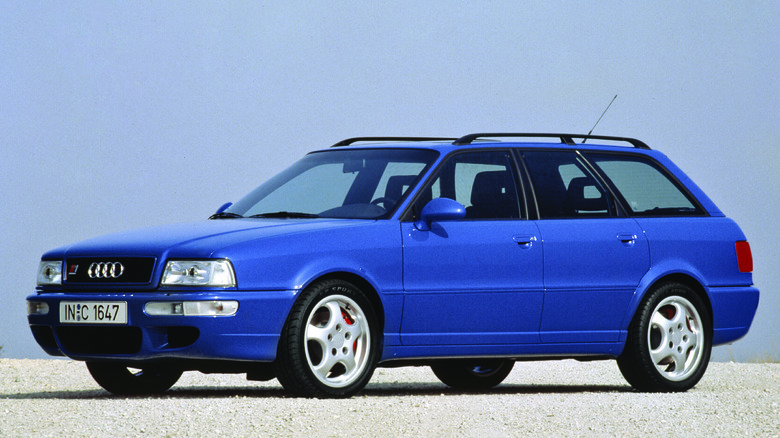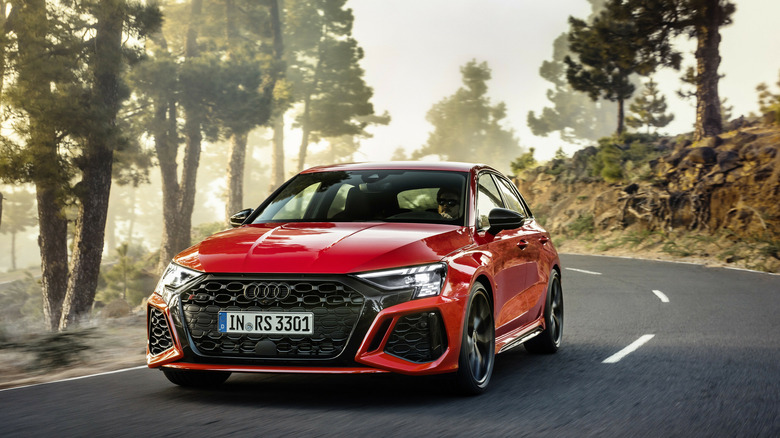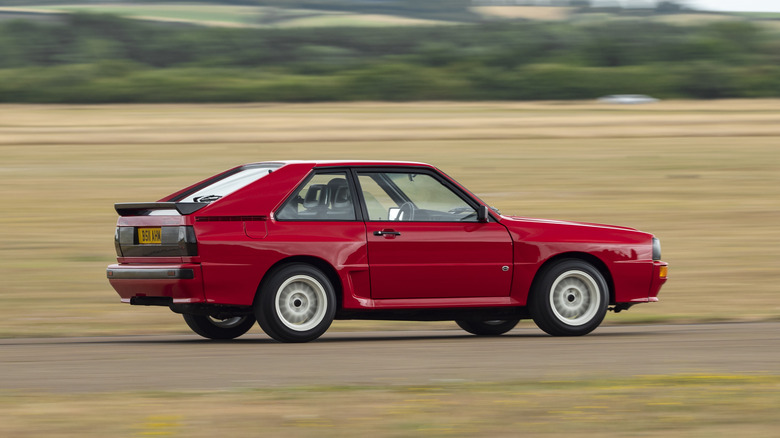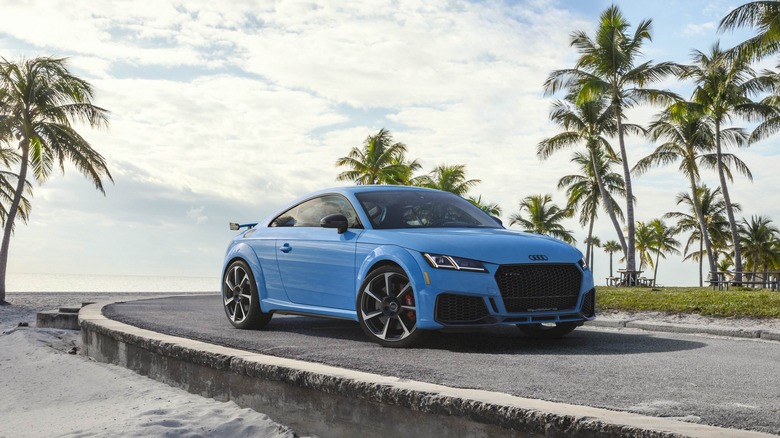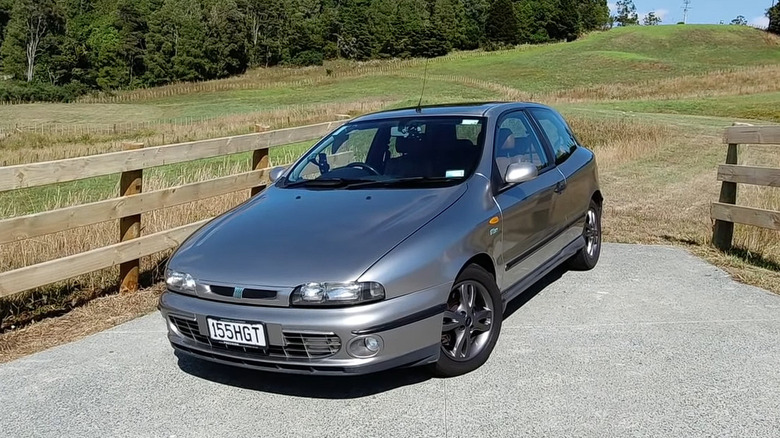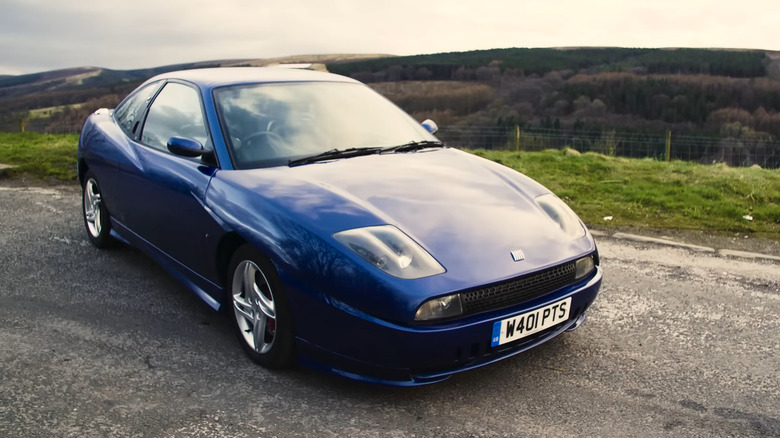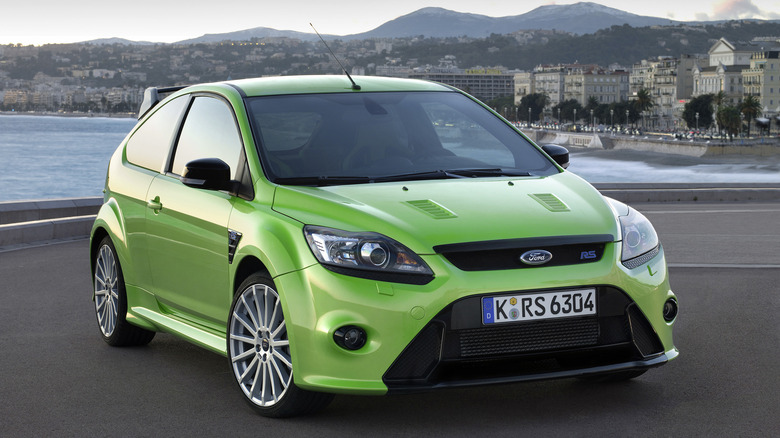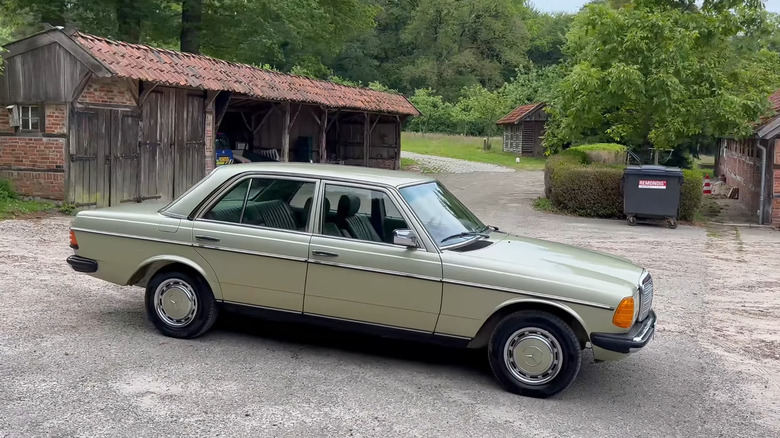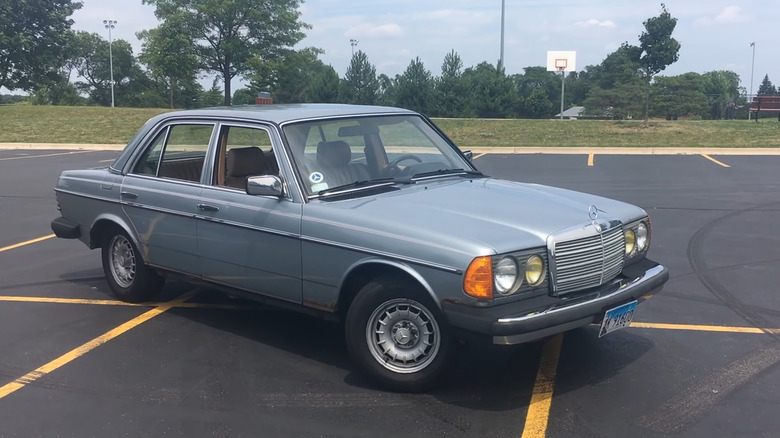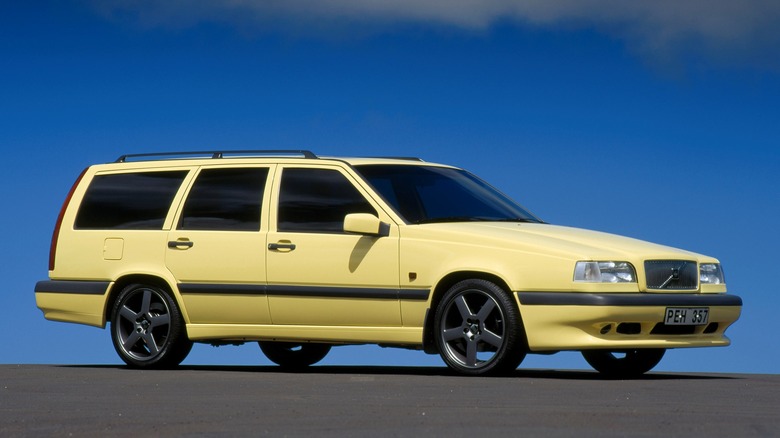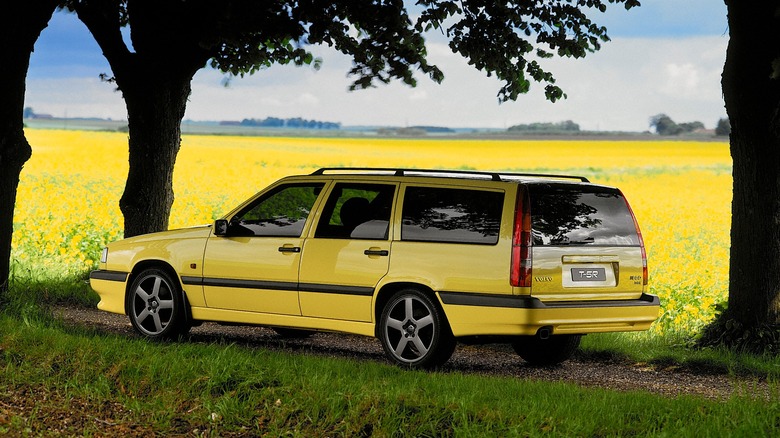The Best Cars Ever Built With An Inline-5 Engine
Four-cylinder engines have been propelling compact and mid-size vehicles for over a century. Compact dimensions, low price, good power, and excellent fuel economy made them the preferred choice for almost every staple name in the automotive industry. However, as much as inline-4 engines are economical, they don't exactly offer a special driving experience. Most of them sound quite thrashy and don't have the smoothness of six-cylinder or eight-cylinder engines. The problem is you can't fit most of those larger powerplants in compact vehicles.
Enter the inline-5 engine. An invention that we first saw in a naturally-aspirated diesel ( the Mercedes-Benz W115 240D 3.0) soon captured the performance car world and became an integral part of Audi's dominant Quattro sports cars. Not only that, but the inline-5 also brought better refinement in smaller vehicles. It is a more balanced engine than an inline-4, with smoother power delivery and much better sound, but still remains compact. As such, the inline-5 has been used in both transverse and longitudinal layouts, from sports cars to luxury cars. And the fact that it's not as represented in the industry as four-cylinder or six-cylinder engines gives it more cachet and makes it somewhat of an exotic powerplant.
But what are the best cars ever that have an inline-5 under the bonnet? Well, buckle up because, in this list, we'll present you with inline-5 vehicles that left a lasting impression, either by pushing the performance boundaries or bringing something new to the table. 1-2-4-5-3, let's go!
Alfa Romeo 159 JTD Ti (2005 to 2010)
Looking at the Alfa Romeo 159, it's hard not to get excited. Even today, it demands attention with its eye-grabbing design and angry front end. In my eyes, it even looks better than the latest Giulia, although Alfa's new sports sedan is more engaging. The 159 had other qualities that made it stand out in the sports sedan segment in Europe, too. In the 2000s, Common Rail turbodiesel engines were all the rage in the Old Continent, powering everything from compact cars to luxury barges. And one of the most interesting was the 2.4-liter inline-5 unit in the 159 JTD Ti, producing 207 hp and 295 lb-ft of torque. It's a sporty model, carrying the Turismo Internazionale moniker of many famous past Alfa Romeos.
I was never very interested in turbodiesels, but driving the 159 JTD Ti made me appreciate them more. To begin with, there was none of that four-cylinder diesel cacophony – the inline-5 diesel was much more pleasing to the ears. It was smoother, too, and revved more easily. As a result, 159 JTD Ti sedans are still a common sight in enthusiast circles in Eastern Europe, most of them tuned past 250 hp and straight-piped to produce an almost race-car-like noise.
Even stock, this handsome Italian sedan reaches 60 mph in 7.6 seconds and has a top speed of 145 mph while returning over 30 mpg combined. It handles neatly, too, despite being a front-wheel-drive vehicle. There is even a six-speed manual for that "Dolce Vita" vibe!
Audi RS2 Avant (1994 to 1995)
In the beginning of the 1990s, wagons were gaining an image of practical but boring vehicles — cars for old people. However, Audi wanted to change that perception and create a wagon that would beat supercars while remaining practical. To make it that more special, Audi went to Porsche for some engineering know-how. The teamwork culminated with the RS2 Avant — the world's first super-wagon.
I've been a fan of the RS2 Avant since it first appeared in auto magazines. Not just because it was good-looking, but because it came with some extremely impressive numbers. Up front, the RS2 Avant packs a turbocharged 2.2-liter inline-5 — a small engine, for sure, but Porsche's and Audi's engineers brought it to 311 hp and 302 lb-ft of torque. The result — a 0-60 mph sprint of 4.8 seconds and a top speed of 163 mph. For illustration, the 1994 Acura NSX needed 5.2 seconds to reach 60 mph and stopped accelerating at 162 mph. Now you know why my jaw dropped.
Look deeper, though, and the RS2 Avant is even more impressive. It has a Quattro all-wheel-drive system for better traction, a 40-mm lower suspension, and huge Brembo four-piston caliper brakes. The short-shifting six-speed manual is the crowning touch that turned the RS2 Avant into an automotive icon. Accordingly, the RS2 is not just one of the best inline-5 cars but also among the best German cars in history!
Audi RS3 (2011 to Present)
Hot hatches have become so good they can compete with supercars on most roads, but the raspy noise of their turbocharged four-cylinder engines can take away from the experience. Some even sound okay, but none comes close to the wonderful barking noise of the inline-5 in the RS3. Audi's compact mega-hatch (and later sedan) is not without its issues — for most of its lifetime, it hasn't been a particularly exciting car to drive in the corners. Still, Audi found the right handling formula in the latest RS3, courtesy of an upgraded Quattro AWD with a trick rear differential. It even has a dedicated drift mode!
Even so, the handling has never been RS3's selling point — the biggest attraction was always the turbocharged inline-5. Fantastic sound aside, the 2.5-liter engine had the figures to back its reputation. In the latest generation RS3, it produces 401 hp @6,500 rpm and 369 lb-ft of torque @3,500 rpm. Add a quick-shifting seven-speed dual-clutch to the equation and Quattro's fantastic acceleration traction, and you get a 0-60 mph time of just 3.3 seconds! Even the first-gen 2011 Audi RS3 with 340 hp reached 60 mph in 3.8 seconds, a supercar-rivaling number at that time.
What makes the RS3 even more memorable is the fact that it will probably be the last inline-5-powered vehicle. A next-gen swan-song model might still house a five-cylinder, but from 2026, Audi will only launch new EVs.
Audi Sport Quattro (1984 to 1987)
Did you think we would leave out Audi's most important car in its history? Of course not! The Audi Sport Quattro showed the world that AWD has a place in regular passenger cars while dominating Group B racing and becoming a rally icon. Better yet, Audi gave enthusiasts a taste of its special rally sauce in the road-going Sport Quattro, which, like its rally counterpart, pushed the performance boundaries.
And the reason why it's the Sport Quattro rather than the Ur-Quattro is that it is much, much wilder. Barbarous, in fact. Namely, Audi engineers cut 12.6 inches from the Ur-Quattro's 99.4-inch wheelbase and used lightweight carbon Kevlar and fiberglass for the body panels. These changes reduced the weight by 200 pounds, resulting in a 2,800-pound curb weight — impressive for an AWD sports car. The mega-tight wheelbase also makes the Sport Quattro very responsive in tight corners — almost to a fault. Still, the Quattro AWD system is always there to keep things planted and secure. No wonder it won so many races!
However, the 2.1-liter turbocharged inline-5 unit producing 306 hp and meaty 258 lb-ft of torque is equally insane, as it brings the Sport Quattro to 60 mph in just 4.8 seconds. Not impressed? A V8-powered 1982 Ferrari 308 GTS QV achieved the same sprint in 6.7 seconds. Sheesh!
Audi TT RS (2009 to 2023)
Enthusiasts don't talk about the Audi TT as much as they talk about an MX-5 Miata or a GR86, probably because it was always based on a Golf/A3 FWD platform. But the most powerful RS version of this handsome coupe is a riot. Even the first-gen TT RS, introduced in 2009, packs a 2.5-liter turbocharged inline-5 producing 340 hp and 332 lb-ft of torque, enough for a 0-62 mph time of just 4.6 seconds — with a six-speed manual! And that was only the warm-up phase.
In 2012, Audi increased the engine output to 360 hp in the TT RS Plus, resulting in a 0-62 mph time of 4.3 seconds with the six-speed manual or 4.1 seconds with a 7-speed dual-clutch automatic. Then, in 2018, Audi introduced the wildest TT RS to date, producing 400 hp and 354 lb-ft of torque. Paired with a 7-speed dual-clutch, this pocket rocket reaches 0-62 mph in 3.7 seconds.
So, the TT RS allows for some rapid-fire acceleration, but the cornering grip the Quattro AWD allows is also neck-snapping. That is true even for novice drivers — there is none of that drifting foolishness here.
Fiat Bravo HGT (1995 to 2001)
Fiat might not seem like an automotive powerhouse to an American, but in Eastern Europe, the dreams of many enthusiasts started with a Fiat. The Italian company was so mighty that it entered almost every country of the Eastern Bloc, plus Yugoslavia, and gave technology to state-sponsored manufacturers. Basically every car manufactured there was essentially a rebadged Fiat.
At the time, the stylish Fiat Bravo HGT garnered more attention in enthusiast circles than even the formidable Golf GTI. Its pièce de résistance was the 2.0-liter inline-5 with 147 hp (152 hp in the 1999-2001 Bravo HGT 155), resulting in a 0-62 mph time of 8 seconds and a top speed of 132 mph. During the 1990s, in these regions, that was considered blazing-fast.
Hearing the 20-valve engine sing, though, was the pinnacle. The Bravo HGT was not an uncommon sight in hill climb racing in Eastern Europe, and it has always excited fans with its raspy engine noise. Little did we know at the time, it was the odd number of cylinders that excited us. Fiat's reliability record is not as exciting, but that doesn't diminish this car's fun credentials.
Fiat Coupe 20V Turbo (1993 to 2000)
The Bravo HGT is a very enticing hot hatch for lovers of naturally aspirated engines. However, Fiat also covered those who wanted more power with its Coupe 20V Turbo. The styling of this 1990s coupe might not be everyone's cup of tea (penned by designer Chris Bangle), though it does have some exotic car vibes to it. Also, it's a front-wheel-drive car based on the Tipo hatch, which hurts its credentials a bit. But judging it upon these things would be foolish, as the Coupe 20V Turbo can annihilate most other compact coupes of the era.
Let me give you some numbers to prove that point. The 2.0-liter inline-5 now had a turbocharger, bringing the horses to 217 and the torque to 228 lb-ft. As a result, the Coupe 20V Turbo could accelerate to 62 mph in 6.5 seconds and achieve a top speed of 155 mph, numbers that trumped its biggest competitor, the VW Corrado VR6. Fiat's coupe also had a five-speed manual at first, with the redesigned 1999 "Plus" model getting a six-speed manual.
On the handling front, the Coupe 20V Turbo is aided significantly by the standard front limited-slip differential, which takes care of torque steer. And despite the added turbocharger, it still sounds angry, making for quite an exhilarating drive.
Ford Focus RS Mk2 (2009 to 2011)
The first-gen Focus RS Mk1 was a rally-inspired hot-hatch with a potent 212-hp 2.0-liter turbocharged engine and dynamic looks to die for. But while the Mk1 was more of a Golf GTI fighter, the Focus RS Mk2 joined the mega-hatch crowd with a larger, 2.5-liter inline-5 turbocharged engine, producing 305 hp and 325 lb-ft of torque.
Naturally, the automotive world expected an AWD drivetrain to compete with cars like the Impreza WRX STI and Lancer Evolution X, but Ford had other plans and kept the Focus RS Mk2 as an FWD vehicle. I even remember dismissing Ford's mega-hatch, thinking torque steer would be a nightmare. Boy, was I wrong.
Thanks to its trick RevoKnuckle suspension, which essentially split the steering arm and the spring/damper to eliminate torque steer, the Focus RS Mk2 went on to become one of the best-handling front-wheel-drive cars in history. The reviews were so positive that front-wheel-drive performance cars were on the cover page once again. The modern-day Civic Type R follows the same recipe, and it's an exceptionally rewarding car to drive.
Of course, because it drives only the front wheels, the Focus RS Mk2 can't accelerate as swiftly as a RWD or AWD car. Thus, it needs 5.9 seconds to reach 62 mph. Even the latter RS500 model with 350 hp and 339 lb-ft of torque needed 5.6 seconds, though this souped-up version never reached U.S. shores. But don't dismiss it based on the numbers — holistically, it's one of the finest hot hatches the world has ever seen.
Mercedes-Benz W115 240D 3.0 & W123 300D (1974 to 1976)
Although inline-5s are not common, the sound of one such engine formed one of my core automotive memories. It had a unique clutter at idle, even from far away, and was ubiquitous in Mercedes-Benz W123 300D taxis. Unbeknownst to me, it was the first production inline-5 engine in history — the revered OM617.
This 3.0-liter unit was built upon the 2.4-liter inline-4 diesel with the idea to give customers a smoother and more potent diesel engine option. It first appeared in the Mercedes-Benz W115 (240D 3.0), where it made 78 hp and 126 lb-ft of torque, enough for a 0-62 mph time of 19.9 seconds. For the brand-new W125 model, Mercedes-Benz cranked it up to 87 hp, cutting the 0-62 time to a respectable 17.8 seconds.
But the OM617 engine has never been about performance. Namely, the OM617 is one of the most reliable engines ever produced, with Mercedes-Benz 300D taxis often covering over 620,00 miles before an engine rebuild. Despite its cluttered noise when idle, it was very smooth during acceleration and quiet on the highway, traits that cemented its special status in automotive history.
Mercedes-Benz 300D Turbo Diesel (1982 to 1984)
Mercedes-Benz quickly answered the public demand for a more powerful diesel engine with the W123 300D Turbo. Utilizing the same 3.0-liter inline-5 engine from the naturally aspirated model and adding a turbocharger, Mercedes-Benz engineers extracted 123 hp and 184 lb-ft. The luxury sedan was available with either a five-speed manual or a four-speed automatic and had a considerably quicker 0-60 mph time of 14 seconds. Most importantly, it pulled forward with five passengers inside and full of cargo — I remember it being unstoppable, even on inclines.
But since the new OM617A turbocharged engine was designed with the boost in mind, it can also be tuned to much higher numbers quite easily — owners easily achieve over 150 hp with the stock turbo. Replacing the turbocharger, fuel pump, and injection pumps will result in a much higher power increase, bringing the OM617A closer to modern turbodiesels. Crucially, despite all of that added complexity, the turbocharged 3.0-liter inline-5 diesel remains one of the most reliable engines in automotive history.
Volvo 850 T5-R & 850 R
Remember the Volvo 850? It was a boxy compact executive sedan that many enthusiasts made fun of, and it's all but forgotten today. But once the performance-oriented 850 T5-R passed you on the highway like a bullet train, nobody was laughing. Well, apart from the driver behind the wheel of the Volvo 850 T5-R.
People not liking 850's styling is understandable (although it aged quite well), but from today's perspective, the 850 T5-R and the improved 850 R are some of the best sleeper picks the automotive world has ever seen. Packing a 2.3-liter turbocharged inline-5 engine, these sports sedans/wagons are certainly not ordinary. The sound coming from the engine is as pleasant as it gets, and the shove it gave you in the back once the turbo spooled was nothing short of astonishing. That turbo pull left a lasting impression and made me appreciate Volvos.
The Swedish powerhouse has the numbers to prove that — the 237-hp 850 T5-R needs 6.9 seconds to reach 62 mph, while the improved 247-hp 850 R made the same sprint in 6.7 seconds. You could have it with a five-speed manual or a surprisingly good four-speed automatic. Both cars had a 155-mph top speed, which is fast even by today's standards. They are also front-wheel drive, though without significant torque steer issues.
But the best thing about the 850 T5-R and 850 R is that they are great family cars, particularly the wagon with its massive 28 cubic feet of cargo space. Even today, parents can appreciate that practicality while smiling their way to the holiday destination.
Why These Cars?
I am turning 40 years old this year, and cars have always been my passion. Naturally, I was interested in every vehicle on the road, its performance numbers, and its unique technology. The models I chose for this list are inline-5 cars that left the biggest impression, be it after driving or being driven in one or just reading about them in magazines.
Of course, I made sure the best cars with inline-5 engines are memorable and historically significant, and I believe that each one of them deserves a classic status. Just so there is no confusion, the list is in alphabetical order. As always, feel free to disagree — we all have different tastes in cars!
